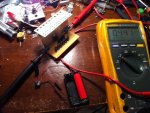Zener over series/parallel regular diodes: advantages:
smaller
simpler
disadvantages:
far more costly
can be difficult to find, especially in high powers
good for simulating only one voltage
My thinking was to get two or three, design the PCB with jumpers or a switch that routes through matching Vf Zener for red, blue or violet.
Smaller size, and is per design as you said.
Ease of build is worth $ in some cases, rather than soldering 9 or 10 diodes.
I guess the answer I am looking for is that it CAN be done, just maybe more expensive and the main thing is finding the high wattage zeners.
I'll look into it, thank for the tips!
EDIT: found this...
The maximum current through a zener diode is determined by ...
I = P / V * where I = current, P = zener power rating, and V = zener voltage rating.
For example, a 27V 1W zener can carry a maximum continuous current of ...
I = 1 / 27 = 0.037A = 37mA
For optimum zener operation, it is best to keep the current to a maximum of 0.7 of the claimed maximum, so the 27V zener should not be run at more than about 26mA. This becomes the base current for the power transistor, and assuming a current gain of 25, that means the total 'composite zener' current is ...
26 x 25 = 650mA
The voltage is increased slightly (to about 27.7V), and the power rating is now ...
P = V * I * = 18W (minimum)
A darlington transistor can also be used for higher current, but will add around 1.5V to the zener voltage. Whether this will cause a problem or not depends on the circuit itself, and is not something that can be predicted in advance.
Construction
Construction is not critical, but a heatsink will almost certainly be needed for Q1. Using a clip to attach D1 to the heatsink will allow a higher dissipation, and will allow you to operate the zener at its maximum operating current. Select Q1 to suit the application - in many cases, a raid on the junk box will almost certainly provide something usable. R1 can be 0.25 or 0.5W.




